Among 10 billion RISC-V chips shipped globally by 2022 half were made in China.
To counter U.S. sanctions and reshape the global semiconductor industry China is increasing its reliance on geopolitically neutral RISC-V for high performance chips, according to the observable trends. The People’s Liberation Army’s (PLA) Academy of Military Sciences has been at the forefront, using RISC-V, as demonstrated by a recent patent publication.
RISC-V is an open source instruction set architecture. It offers a simpler and potentially more energy-efficient alternative to x86 and Arm architectures, controlled by U.S. and UK firms, respectively. Amidst widening U.S. restrictions on China’s access to the most advanced semiconductors and chip-making equipment, RISC-V emerges as a crucial part of Beijing’s strategy to reduce dependence on Western technology.
China’s RISC-V ecosystem is the most mature globally as a result of its necessity to withstand import restrictions. In China, at least $50 million have been invested in projects involving RISC-V between 2018 and 2023, many sanctioned by Washington. This is according to a Reuters review of around 100 Chinese academic articles, patents, government documents and tenders, and statements from research groups and companies.

Among 10 billion RISC-V chips shipped globally by 2022 half were made in China. Funding for RISC-V startups in China reached $1.18 billion in 2022. Around 1,061 patents involving RISC-V were published in China last year, substantially up from 10 in 2018.
The emergence of RISC-V raised concerns among U.S. lawmakers about the potential need for export restrictions around the technology. The move is unlikely to happen as it could hinder the development of new and improved chips globally.
While the RISC-V chips’ performance lags Arm in complex computing tasks, the gap is closing as startups increase and more tech companies invest in the standard, said Richard Wawrzyniak, principal analyst at the market research firm SHD Group.
China’s military and research institutions have also shown interest in RISC-V, developing technologies ranging from automotive microcontroller units (MCUs) to chips designed to secure against cyberattacks.
The PLA-run National University of Defense Technology has been in the top 15 for RISC-V patents filed in China since 2018. Researchers at Beihang University, involved in the development of Chinese military aircraft and missiles, presented the design for a RISC-V chip that processes radar signals.
![]()
Institute of Software at the Chinese Academy of Sciences (CAS), a PLA supplier, developed a RISC-V chip to prevent a type of cyberattack. The CAS Institute of Computing Technology, which is under U.S. sanctions, unveiled the second generation of ‘Xiangshan’, a RISC-V high-performance PC chip, and ‘Aolai’, a RISC-V operating system, last year.
Despite RISC-V’s growing prominence and the advantages, it has yet to disrupt the dominance of x86 and Arm duopoly. With the increasing demand for AI chips and the push for technological self-sufficiency, RISC-V presents a promising avenue for China and other countries to navigate geopolitical tech restrictions and innovate the semiconductor industry.




